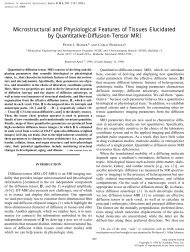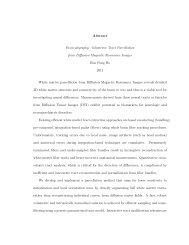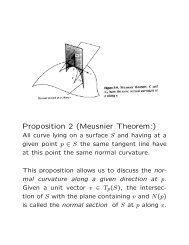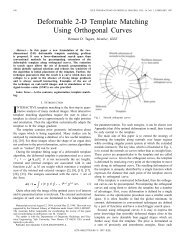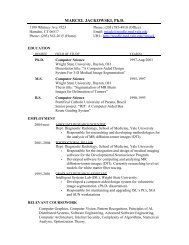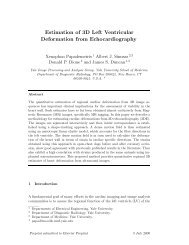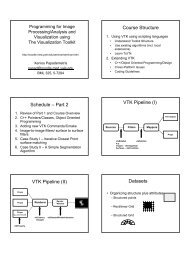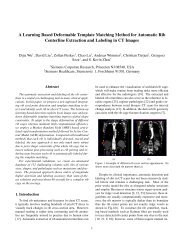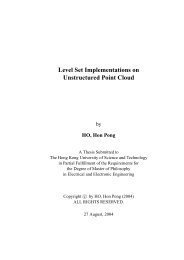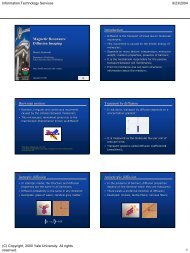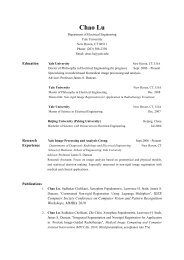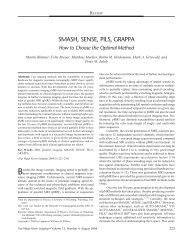Pulsed-field gradient nuclear magnetic resonance as a tool for ...
Pulsed-field gradient nuclear magnetic resonance as a tool for ...
Pulsed-field gradient nuclear magnetic resonance as a tool for ...
You also want an ePaper? Increase the reach of your titles
YUMPU automatically turns print PDFs into web optimized ePapers that Google loves.
320<br />
PRICE<br />
sured in conventional NMR imaging Ž 4143 . .<br />
However, where<strong>as</strong> conventional imaging returns<br />
the ph<strong>as</strong>e-sensitive spatial spectrum of the restricting<br />
pore, EŽ q, . me<strong>as</strong>ures the power spec-<br />
Ž .2 trum, S q . Thus, EŽ q, . is sensitive to average<br />
features in local structure, not the motional characteristics.<br />
Further, because EŽ q, . me<strong>as</strong>ures the<br />
power spectrum of SŽ q . , Fourier inversion cannot<br />
be used to obtain a direct image of the pore.<br />
However, the q-space imaging h<strong>as</strong> the potential<br />
to give much higher resolution than conventional<br />
k-space imaging, since the entire signal from the<br />
sample is available to contribute to each pixel in<br />
R-space Ž i.e., R, the dynamic displacement. Ž 85.<br />
rather than from a volume element Ž i.e., voxel. <strong>as</strong><br />
in conventional k-space imaging. Thus, the resolution<br />
achievable in q-space imaging is limited<br />
only by the magnitude of q.<br />
We will illustrate the diffraction effect with<br />
recourse to diffusion in between parallel plates<br />
Ž see the inset to Fig. 6. with a separation of 2 R<br />
Ž n.b. not R, the dynamic displacement . . For this<br />
geometry, the analysis linking the experimental<br />
variables and the diffusion of the particle is per<strong>for</strong>med<br />
in a manner entirely analogous to that<br />
already presented <strong>for</strong> free diffusion earlier, except<br />
that the mathematics is more tedious. Briefly,<br />
the solution to Eq. 26 <strong>for</strong> this geometry with the<br />
initial condition of Eq. 25 is given by Ž 66.<br />
ž /<br />
2 2 n Dt<br />
PŽ z , z ,t. 0 1 12Ýexp 2<br />
Ž 2R.<br />
n1<br />
ž / ž /<br />
nz0 nz1<br />
cos<br />
cos . 91 2R 2R<br />
If Eq. 91 is substituted into Eq. 75 ,<br />
except that<br />
we now write the equation in terms of q, we get<br />
the SGP solution Ž 56 . ,<br />
21cos Ž2qŽ 2 R..<br />
EŽ q,. 2<br />
Ž2qŽ 2R..<br />
ž /<br />
2<br />
n D<br />
42q2R Ž Ž .. exp <br />
2 2<br />
Ý<br />
n1<br />
2<br />
Ž 2R.<br />
n<br />
1 Ž 1. cosŽ2qŽ 2 R..<br />
<br />
. 92 2 2<br />
2<br />
Ž2qŽ 2R.. Ž n.<br />
Figure 6 A plot of Eq, Ž . versus q calculated using Eq. 93 <strong>for</strong> two values of the<br />
interplanar spacing Ž i.e., slit width; 2 R . , 2R26 m Ž . and 30 m Ž . . The<br />
diffractive minima are clearly R dependent, and in the c<strong>as</strong>e of planes, the minima occur<br />
when q n2 R Ž n1, 2, 3 . . . . . Generally, when there is only one characteristic distance,<br />
it is more convenient to plot the abscissa in terms of the dimensionless parameter qR Žsee<br />
Fig. 8 . .



